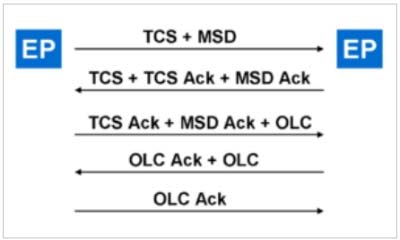Minimum Number of H.225 Messages
Question
What is the minimum number of H.225 messages required to establish an H.323 call with bidirectional media?
Answers
Explanations
Click on the arrows to vote for the correct answer
A. B. C. D. E.B.
A typical H.245 exchange looks similar to below figure After this exchange of messages, the two endpoints (EP) in this figure would be transmitting audio in each direction.
The number of message exchanges is numerous, each has an important purpose, but nonetheless takes time.
For this reason, H.323 version 2 (published in 1998) introduced a concept called Fast Connect, which enables a device to establish bi-directional media flows as part of the H.225.0 call establishment procedures.
With Fast Connect, it is possible to establish a call with bi-directional media flowing with no more than two messages, like in figure 3
Fast Connect is widely supported in the industry.
Even so, most devices still implement the complete H.245 exchange as shown above and perform that message exchange in parallel to other activities, so there is no noticeable delay to the calling or called party.

To establish an H.323 call with bidirectional media, the minimum number of H.225 messages required is 3.
Here's a breakdown of the three messages and their purposes:
ARQ (Admission Request): The first message is sent by the originating endpoint to the gatekeeper, requesting admission to the network. The ARQ message contains information such as the source and destination IP addresses, call type, and bandwidth requirements.
ACF (Admission Confirm): The gatekeeper sends an Admission Confirm message to the originating endpoint, providing the endpoint with the necessary information to establish the call. The ACF message includes the IP address and port number of the destination endpoint, as well as the call identifier (Call-ID).
SETUP: The originating endpoint sends a SETUP message to the destination endpoint, which contains information such as the call identifier, codec type, and destination IP address. The SETUP message also includes the H.245 negotiation messages necessary to establish bidirectional media.
Once the SETUP message is received by the destination endpoint, the H.245 negotiation process begins, which involves exchanging several H.245 messages between the endpoints to negotiate the parameters for the call.
Therefore, the minimum number of H.225 messages required to establish an H.323 call with bidirectional media is three.